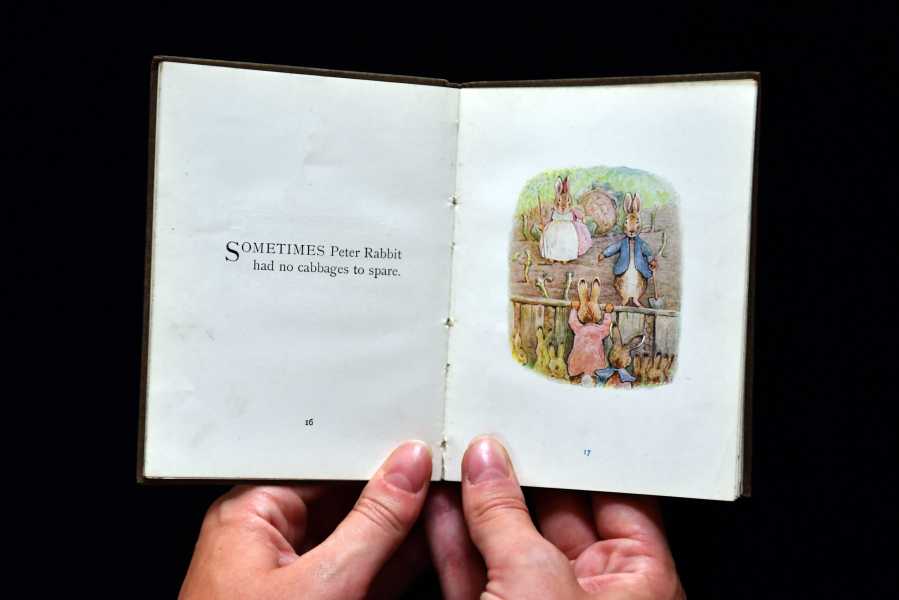Peter Rabbit’s world is cozy but rife with peril.

The Morgan Library & Museum
February 23–June 9
Like a lot of kids with discerning parents, when I was growing up, I owned a box set containing all twenty-three of Beatrix Potter’s Peter Rabbit tales for children. It is sitting beside me as I write these words, though of course some of the books are missing and all the white slipcovers have long since disappeared. I have loved these books since before I could read, for the same reason that everyone else loves them: The illustrations are comforting and cozy, just like the chamomile tea which old Mrs. Rabbit gives Peter after his misadventure in the McGregor garden.
As soon as I learned to read, I found that Potter’s words are often even more entertaining than her pictures. The charming art sometimes belies the content of the stories. Beatrix Potter’s world is comforting and cozy, but it is also rife with peril. Animals behave like animals: rats hunt kittens; foxes trick hens; and pigs live in constant fear of the butcher. Potter’s human beings are amusingly lifelike as well. When they get involved in these affairs, they often prove themselves not much more civilized than the animals. Sometimes they are only dolls, playacting as human beings.
For children reading these books for the first time (and for parents rereading them for the ten thousandth time), Potter’s charm derives largely from the wry seriousness with which she treats her artificial little world. Her characters wear waistcoats and smoke pipes and worry about their taxes, but they also claw and bite at each other, just as we do in real life. “Old Mr. Bunny had no opinion whatever of cats,” she writes of Benjamin Bunny’s father before he thrashes a cat that has imprisoned his son under a basket. He then switches his son for his recklessness. My daughter laughs every time I read that sequence aloud; I smile whenever I remember it. This is just what it means to grow up.
I think everyone who grew up on Beatrix Potter has some similar memory of a story or even of one line. Once made, her impression on the mind is lasting. Steven Runciman, who wrote a wildly popular revisionist history of the Crusades in the 1950s (these days generally unread), often claimed that she taught him everything he knew about storytelling. I don’t know if most people would go that far, but every now and then, I’m sure, those who read her as a child find themselves remembering at odd hours a stray line from Peter Rabbit or Squirrel Nutkin or Jeremy Fisher.
For myself, my favorite of Potter’s books is probably The Tale of Ginger and Pickles, which is less a story and more a diatribe against the credit economy with a few pictures attached. It concerns a yellow tom-cat (Ginger) and a terrier (Pickles) who run a store frequented by moles, mice, rabbits, and the like. Ginger cannot bear to serve the mice—he wants to eat them—and Pickles feels the same way about the rats. In any case, the store is popular with these animals all the same because its owners never collect on anyone’s line of credit. Obviously, this is no way to run a business, and soon Ginger and Pickles are forced to eat their own goods. Pickles has no money for a dog license and lives in constant terror of the police. Ginger falls behind on the store’s taxes, and so the two close up shop. A succession of stores follow them, each with their own fatal flaws, until a chicken named Sally Henny-Penny opens up a successful shop, advertising her services with some lines artfully lifted from Christina Rossetti’s “Goblin Market.”
Subscribe Today Get daily emails in your inbox Email Address:
The humor in all this is the utmost seriousness with which the vagaries of running a small business are related. “It would never do to eat our customers,” Pickles remarks sadly. “They would leave us and go to Tabitha Twitchit’s.” “On the contrary, they would go nowhere,” Ginger replies gloomily. And later, Potter writes of another failing shop: “When Mr. John Dormouse was complained to, he stayed in bed, and would say nothing but ‘very snug’; which is no way to carry on a retail business.” I should add here that Potter herself was a shrewd businesswoman, a natural inventor who played a large role in inventing modern kids’ books merchandising.
In fact, Potter was a woman of many gifts, among them a knack for sheep farming, a passion for land conservation, and the ability to organize groups of Girl Guides. In all things, she was guided by her keen powers of observation, both of the natural world and of the ways in which people interact with it. There was nothing sentimental or childish about her. She was not maternal, but she was said to have been warm all the same. It comes as no surprise that she had no children of her own.
This side of Potter comes through clearly at an exhibition of her artwork on view at the Morgan Library in New York through June. It includes, in addition to the original illustrations for the Peter Rabbit books, her botanical and mycological studies (she was fascinated by mushrooms) and many of her personal belongings (her gardening shoes were clearly the basis for Benjamin’s clogs). When I took my two-year-old daughter, she made a beeline for the box set of the children’s books placed out on display. Before anyone could stop her, she opened the box and pulled out the copy of Benjamin Bunny and showed it to me—“just like at home,” she said. The security guards at the Morgan were kind enough to let her carry the book around the exhibition until we left. I was once thrown out of a museum for attempting to play George Gershwin’s piano, so I was a bit surprised by this response. But I think it was just the Potter effect: Her work brings out the best in people—a little warmth, generosity, and likely a recollection of one’s own childhood.

This article appears in the May/June 2024 issue
Subscribe Now
Sourse: theamericanconservative.com






